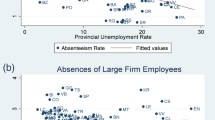Abstract
Reductions in firing costs are often advocated as a way of increasing the dynamism of labour markets in both developed and less developed countries. Evidence from Europe and the U.S. on the impact of firing costs has, however, been mixed. Moreover, legislative changes both in Europe and the U.S. have been limited. This paper, instead, examines the impact of the Colombian Labour Market Reform of 1990, which substantially reduced dismissal costs. I estimate the incidence of a reduction in firing costs on worker turnover by exploiting the temporal change in the Colombian labour legislation as well as the variability in coverage between formal and informal sector workers. Using a grouping estimator to control for common aggregate shocks and selection, I find that the exit hazard rates into and out of unemployment increased after the reform by over 1\% for formal workers (covered by the legislation) relative to informal workers (uncovered). The increase of the hazards implies a net decrease in unemployment of a third of a percentage point, which accounts for about one quarter of the fall in unemployment during the period of study.
Similar content being viewed by others
References
Aguirregabiria, Victor and Cesar Alonso-Borrego. (1998). “Labour Contracts and Flexibility: Evidence from a Spanish Labour Market Reform. ” Mimeo.
Anderson, Patricia. (1993). “Linear Adjustment Costs and Seasonal Labour Demand: Evidence from Retail Trade Firms. ” Quarterly Journal of Economics 108(4), 1015–1042.
Bentolila, Samuel and Giuseppe Bertola. (1990). “Firing Costs and Labour Demand: How Bad is Eurosclerosis. ” Review of Economic Studies 57(3), 381–402.
Bentolila, Samuel, and Gilles Saint Paul. (1992). “The Macroeconomic Impact of Flexible Labour Contracts, with an Application to Spain. ” European Economic Review 36(5), 1013–1047.
Bertola, Giuseppe. (1992). “Labour Turnover Costs and Average Labour Demand. ” Journal of Labour Economics 10(4), 389–411.
Bertola, Giuseppe. (1990). “Job Security, Employment, and Wages. ” European Economic Review 54(4), 851–879.
Blundell, Richard, Alan Duncan and Costas Meghir. (1998). “Estimating Labour Supply Responses using Tax Reforms. ” Econometrica 56(4), 827–861.
Dertouzos, J. and L. Karoly. (1993). “Employment Effects of Worker Protection: Evidence from the U.S.” In Cristoph Buechtermann, Employment Security and Labour Market Behaviour. Ithaca, NY: ILR Press.
Di Tella, Rafael, and Robert MacCulloch. (1998). “Consequences of Labour Market Flexibility: Panel Evidence Based on Survey Data. ” Mimeo.
Eissa, Nada and Jeffrey B. Liebman. (1996). “Labor Supply Response to the Earned Income Tax Credit. ” Quarterly Journal of Economics 111(2), 605–637.
Garcia-Fontes, Walter and Hugo Hopenhayn. (1996). “Creació n y Destrucció n de Empleo en la Economía Españ ola. ” In Ramon Marimon (ed.), La Economía Españ ola: una Visió n Diferente. Barcelona: Antoni Bosch Editor.
Gavin, Michael. (1986). “Labor Market Rigidities and Unemployment: The Case of Severance Costs. ” Board of Governors of the Federal Reserve Discussion Papers in International Finance.
Grubb, David and William Wells. (1993). “Employment Regulations and Pattern of Work in EC Countries. ” OECD Economic Studies 21, 7–39.
Hamermesh, Daniel. 1993. “Employment Protection: Theoretical Implications and Some U.S. Evidence. ” In Cristoph Buechtermann, Employment Security and Labour Market Behaviour. Ithaca, NY: ILR Press.
Heckman, James, Hidehiko Ichimura, Jeffrey Smith, and Petra Todd. (1998). “Characterising Selection Bias Using Experimental Data. ” Econometrica 66(5), 1017–1098.
Heckman, James, and B. Singer. (1985). “Social Science Duration Analysis. ” In J. Heckman and B. Singer (eds.), Longitudinal Analysis of Labour Market Data. Cambridge: Econometric Society Monograph Series.
Hopenhayn, Hugo and Richard Rogerson. (1993). “Job Turnover and Policy Evaluation: A General Equilibrium Analysis. ” Journal of Political Economy 101(5), 915–938.
Krueger, Alan. (1991). “The Evolution of Unjust Dismissal Legislation in the U.S.” Industrial and Labour Relations Review 644–660.
Lancaster, Tony. (1990). The Econometric Analysis of Transition Data. Cambridge: Econometric Society Monograph Series.
Lazear, Edward. (1990). “Job Security Provisions and Employment. ” Quarterly Journal of Economics 105(3), 699–726.
Lora, Eduardo and Marta Luz Henao. (1995). “Efectos Econó micos y Sociales de la Legislació n Laboral. ” Coyuntura Social 13, 47–68.
Ocampo, José Antonio. (1987). “El Régimen Prestacional del Sector Privado. ” In José Antonio Ocampo and Manuel Ramírez (eds.), El Problema Laboral Colombiano. Bogotá: Departamento Nacional de Planeació n.
OECD. (1990). Employment Outlook. Paris: OECD Publications.
Saint-Paul, Gilles. (1996). Dual Labour Markets: A Macroeconomic Perspective. Cambridge, Mass.: MIT Press.
Author information
Authors and Affiliations
Rights and permissions
About this article
Cite this article
Kugler, A.D. The Impact of Firing Costs on Turnover and Unemployment: Evidence from the Colombian Labour Market Reform. International Tax and Public Finance 6, 389–410 (1999). https://doi.org/10.1023/A:1008711819429
Issue Date:
DOI: https://doi.org/10.1023/A:1008711819429




